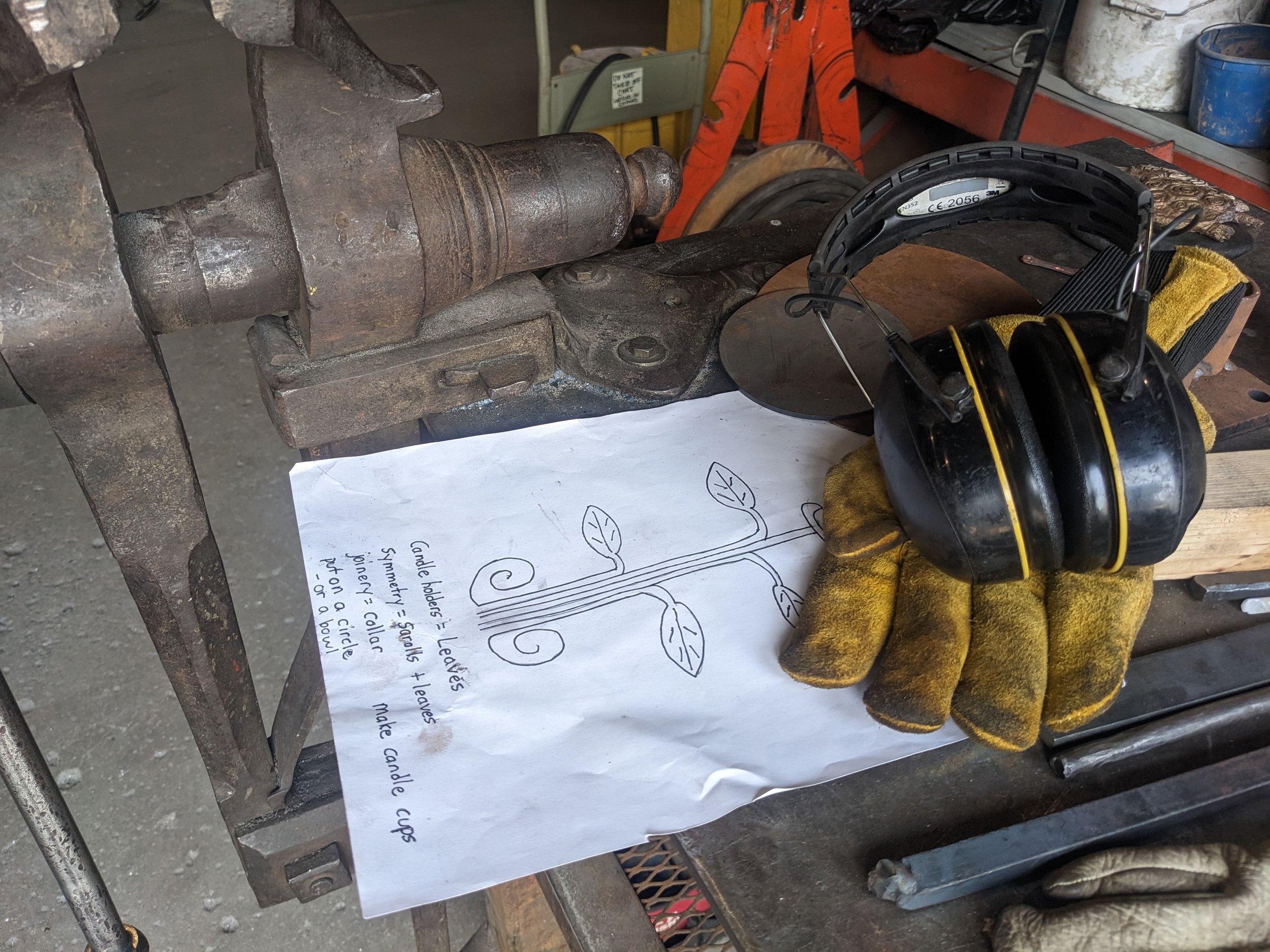Lori Beck: A Therapeutic Approach to Blacksmithing
Every July, Lori Beck embarks on an annual pilgrimage to CAFAC from her home in Michigan. Each year, she’s greeted with a private forge, and plentiful iron stock, and uninterrupted, one-on-one access to blacksmithing instructor Brad Buxton’s guidance.
Lori is one of hundreds of students who take classes at CAFAC to refine their skills in the fire arts, including welding, stained glass, metal casting, neon, enamel, and–her medium of choice–blacksmithing. Her passion for the art form started as a child, when she used to watch her grandfather forging at home and looked forward to visiting historic villages specifically for the blacksmiths.
“Once I found the blacksmith shop, that was it,” Lori laughs. “I was done. Leave my lunch with me and I’ll be there two and a half hours later.”
Lori shapes hot metal at her personal workstation in the CAFAC shop
For Lori, blacksmithing has been more than a creative outlet. It’s reconnecting to childhood experiences–and it’s therapeutic.
“The reason I say that is because I was involved in four, for lack of a better term, terrorist attacks,” Lori explains. “One of them I had a building fall on me. Another I got thrown about 20 feet. And the other two… are more like an implosion. I can’t describe what it felt like.”
In addition to the physical trauma they brought, these experiences planted the seeds for an intense, deep-seated fear of fire.
“It’s anything with fire,” Lori clarifies. “Sparks, particular sounds like a welding instrument. The popping noise from the forge. Holding on to a flint striker–just about anything you can think of brings about a fear in me. It’s all got to be rewired because of what happened.”
It’s taken Lori a long time to become comfortable working with a flame. On her first day, she recalls, seeing a forge from 20 feet away was enough to stop her in her tracks.
“I literally froze,” she recalls. “So I had to work with it gradually. Gradually approach the forge. Be told that it’s fire, you’re going to make something with it.
“The element that was missing for me was the respect for fire. The people here [at CAFAC] know what it can do. For me, everything in here was out to hurt me. I was basically trying to convince my brain that it was okay.”
With time, patience, and self-compassion, she was able to start forging with a piece of extra long metal stock.
“A lot of it was keeping at it, trying to move forward and get used to the forge,” she explains. “Now make it shorter, that piece of metal. Keep shortening it.”
Starting with a hook–one of the most popular beginner blacksmithing projects here at CAFAC–Lori started to see that fire didn’t just mean danger. It could also represent creation.
Once she started to internalize that respect for fire rather than a fear of it, “that’s when I could really start blacksmithing and healing,” Lori says, “making all these different connections.”
Little by little, Lori expanded her repertoire of projects. Leaves, fire pokers, small sculptures–she keeps them all as a reminder of how far she’s come. Her most memorable project? A seven-foot-tall tripod for campfire cooking, requested by a friend.
“I have to giggle at that one every time I think about it,” Lori laughs, “I'm only five foot three. I'm working with these seven foot poles, bending them and hammering on them. They’re almost a foot and a half taller than me!”
Gloves and earmuffs rest on a workbench, on top of a sheet describing the project Lori’s working on: a candleholder designed to look like a symmetrical plant, with curling vines and broad leaves.
Lori’s journey isn’t always a straight path forwards. Now and again, there are setbacks.
“It all depends on how I relate to the fire that day,” says Lori. “Part of my brain goes ‘Okay, you’re blacksmithing, you’re lighting a forge, you're hammering on hot metals.’ That's part of my brain.
“The other part of my brain is going, you're in a complete danger situation, get away right now, because you're back in the time of the explosion, you're seeing fire, you're smelling smoke, you're seeing sparks,” she explains. “It's moment-to-moment. And, you know, even those moments are not so horrible anymore. They still are scary, but nothing that I cannot overcome.”
One of the most significant signs of Lori’s healing is a change in her mindset since she’s started blacksmithing. In the beginning, everything in the forge was out to hurt her. Now she recognizes that it can hurt her, but isn’t destined to.
“For someone like me to come from where I was, four and a half years ago, has taken a lot of work,” Lori says. “It's been a rough, hard journey you know. I won't deny that one minute, but when I accomplish things–even the little things–it just makes all the difference in the whole outlook of the journey, from where I’m at to where I'm going.
“And I'm just going to keep going forward as much as I can.”
Lori smiles behind a table holding some of her finished projects, including two inspired by plants.



